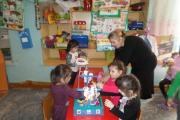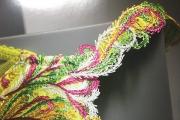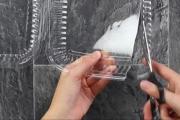Bruges crochet patterns. How to start knitting Bruges lace - tips and mk for beginners
Crocheting has its origins in the distant past. From ordinary threads and a curved knitting needle, you can create a real work of art. Are you familiar with crocheting Bruges lace? Schemes and models of it, which are most often used by needlewomen, we will consider today.
Bruges lace - weightless beauty
Crochet, Bruges lace, models, patterns - everything that interests you, we will consider in our article. Novice needlewomen have not yet encountered this knitting technique. Perhaps this lace is the most extraordinary and air pattern... As a rule, Bruges lace consists of separate ribbons, which are connected by columns with crochets and chains of air loops.
Most often, napkins, tablecloths, shawls and scarves are knitted in this technique. You can show your imagination and bring to life even the most daring ideas. In our country, Bruges lace is called Vologda lace. If you master the braid weaving technique, you can make an openwork dress or bolero for yourself.
First time in first knitting class
Today we will show you how to make Bruges lace for beginners. This process is painstaking and requires your full concentration and perseverance. Study the diagram carefully and follow the description. And in order for you to have no difficulties, you first need to master the technique of knitting air loops and columns with crochets. A little tip: a crochet hook for creating lace should be chosen no more than 2 mm in size.

Necessary materials:
- yarn;
- hook.
- The formula for creating lace in Bruges is simple: the more original loops and columns, the wider the lace is. From familiar loops, you can create a variety of patterns using various joining techniques.
- Let's pick up 14 air loops.
- Insert a hook into the eighth loop and knit a column with a crochet. Here's a loop we get.

- By analogy, pulling the hook into an air loop, we knit a column with a crochet.
- There should be seven more of them.

- Turn the product over to the opposite side.
- Let's pick up a chain of seven air loops.
- Now carefully: we insert the hook into the last column of the previous row and knit a column with a crochet.

- So, we have already knitted one column with a crochet. By analogy, we knit six more.
- We stretch the hook into each air loop of the previous row.

- The first two steps are the basic knitting pattern.
- We continue to knit the braid to the desired width.

- Look: we have got an original ribbon, which has a dense weave inside, and openwork lines on the sides.

- A distinctive feature of Bruges lace is the connection of the knitted braid. There are many options, but we'll start with simple twists and turns.
- We collect four air loops and connect them to the previous row with a double crochet.
- Continuing knitting, we form three more columns with crochets.

- We continue to knit by analogy, connecting the braid.
- It turns out here is such an openwork rounding.

- We turn the product over to the opposite side and crochet eight air loops.

- We knit four columns with crochets.

- We collect again a chain of four air loops.
- We stretch the hook into an openwork half-ring and knit with a single crochet column.
- Once again we collect a chain of four air loops and return again to the previously described scheme, we knit a dense part of our lace.

- Similarly, we knit the product to the desired size.
- This technique of connecting the knitted braid allows us to wrap the lace in any direction, giving the product the desired shape.

Create your lace Bruges
We are always attracted by something unknown, overseas. So Bruges lace was no exception. The master class will help novice needlewomen create an exclusive product. Several different techniques braid connections, in particular:
- knitting columns of different heights;
- alternating single crochet columns with air loops;
- only single crochet columns.
But if you dream up and apply several connecting techniques in one piece, you will get a unique pattern. We turn on the imagination and take the hook in our hands.

Necessary materials:
- hook;
- yarn.
Step-by-step description of the creative process:

Bruges lace. Overview + diagrams


Author's text ... Knitted braid in Bruges lace is laid out according to the pattern, joining in the process of knitting. The beginning and end of the tape, forming a closed loop, can be sewn with a needle or crocheted with a "lace connection".
In this technique, you can use different types of braid. The main feature of almost all types of braid is that the lifting loops form a loop on the side, with the help of which the braid is connected in patterns.


When knitting some joints, such a loop is skipped, and instead of it, ordinary lifting loops are knitted.
Lace is knitted according to the scheme, which indicates the sequence of knitting and methods of connecting its individual motifs and fragments.
The braid is knitted in rows in two directions. Its width can be different.
The connection of the braid takes place in the process of knitting for the buddies formed by air loops. The connection is made with an air loop, a single crochet, a double crochet, depending on the pattern.
By connecting two braids in the process of knitting with the same columns, we get their parallel arrangement.

If you change the height of the columns, then the stripes will diverge at a slight angle. The bend of the braid can be obtained by knitting columns of different heights and connecting the groomsmen to each other from the inner side of the bend.
This article is for those who love unusual and original crochet patterns. Bruges lace shown here is a modern version of antique needlework.
A few words about lace
At first, knitting was a craft for men, but gradually it moved into the category of women's needlework. Like any handicraft, lace knitting is very calming for the nervous system. Openwork interior items always add coziness to the apartment. Even a small napkin on a coffee table can set the mood for the entire interior. Just don't overdo it. A lace dress or accessories are great for creating feminine looks. To achieve the desired effect and correspond to the modern style, openwork must be used guided by artistic taste and a sense of proportion.

Distinctive features of the Bruges openwork
What is Bruges Lace? The diagrams clearly show that this is a braid laid out in a beautiful, smooth, rounded pattern. It is also called a thorn. Belgian lace is almost three hundred years old. For three centuries, interest in him either faded or flared up again. There is different ways creating a canvas using the technique of "Bruges lace". which you see in front of you on the screen is just one of the options for weaving openwork.

Bruges lace from factory braid
In sewing supply stores, you can find braid with an oblique arrangement of weft threads and with loops evenly spaced along the edges. It is great for creating modern pieces that are reminiscent of old Bruges lace. Models and circuits invented experienced craftsmen, are also suitable for working with ready-made, factory braid. The diagonal arrangement of the main thread makes the braid elastic, therefore thickening is practically not noticeable at the folds of the pattern. You do not need to put such lace under the press to give it a more flatness.

Create a pattern
From this braid, and it is very rarely on sale, lace is created in the following way. A simplified one-color pencil makes a sketch of a flower, a butterfly, etc., the corners are rounded, most of the lines are closed, and now you have an exclusive Bruges lace in front of you. The diagram is enlarged to natural size. Then it is placed on a soft, resilient surface into which pins can be stuck. The braid is laid and pinned on the line of the drawing. The places where the loops touch each other are sewn. This is done with very thin threads and a needle. The color of the threads must match the color of the braid. It turns out a very beautiful canvas. In this way, elegant collars and napkins are made, that is, small items.

The old way of knitting
Bruges lace: napkins, the diagrams of which are presented in this article, garments, resemble the products of Vologda and Flemish craftswomen who worked on bobbins. They did not knit the braid separately so that they could later make a pattern out of it. The stripes were woven, connected and branched, bypassing the pins, directly on the substrate, in accordance with the wide and thin lines picture. Currently, a popular technique is that a long ribbon with loops on the sides is crocheted and joined into a pattern right during the knitting process.

The modern way to crochet
The photographs clearly show the Bruges lace. The diagrams show several options for braid. They are all very simple to implement. Try to knit different ones and choose which one you like best. You are free to treat it like a factory one: tie a long ribbon, place it beautifully on a pattern or on a garment pattern, if you plan to turn the ribbon into a dress, blouse or skirt and fasten it with a thread with a needle and thread or crochet. Even easier, pin the tape on a felt or knitted mannequin. You will immediately see how much more braid needs to be tied.

Fit of lace on the figure
The tape can be expanded taking into account the bends of the body, and then, without creating darts and embossed seams, you will achieve a perfect fit on the figure. The manufacture of the sleeve causes some difficulty. Here is the advice. Place the fork on the mannequin, taking into account the armhole as on a dress pattern with a set-in sleeve. Lay the tape intended for the sleeves on a paper dress, pin in the form of a pattern, sew for loops, fill the gaps with a mesh of air loops or small lace floral motives... Before joining with the main part, press the sleeve down with a heavy press so that the folds of the braid become flatter. It is not yet possible to wash and steam the product, because you will connect the sleeve with the shelf and back with the same threads using chains of crocheted air loops.

When all the details of the dress are ready and connected, it can be wet-heat treated without the fear of uneven shrinkage. At home, this is usually washing, starching (if the item is made of cotton) and ironing.
Simple and stylish dress
If you change the pattern, making the armholes square, then the sleeves can be knitted rectangular without rounding off on the sides. With such a shoulder girdle, the dress does not have to be narrowed at the waist. This style is considered classic and universal for the owners of slender, thin figures. Try to tie it. Technically it is not difficult, it only requires perseverance. If you take the risk and get down to business, then you get a stylish and elegant dress. Bruges lace, the schemes of which are in this article, are the best fit for such a thing. If it is very transparent, then you can experiment with the choice of a bottom cover dress. It is matched to tone or contrast.

At one time it was fashionable to wear guipure on the lining.This is an interesting option, but there are few situations where it is appropriate, since the bodily fabric of the lining creates the illusion of a naked body. Choose the thread color that best matches your color type and go for it!
Haute couture lace collections
In the collections of many famous designers, there are models made of lace. This is the white collection of Valentino, and the masterpieces of Jean-Paul Gaultier, and others. Couturiers constantly turn to historical costumes and national handicrafts. If you look at each model separately, it becomes obvious - modern fashion very inclined to combine laces of different eras and different peoples in one dress.

The combination of different types of lace
Bruges lace, crocheted from a webbing, often requires additions in the form of elements of Irish, Venetian, sirloin or other lace. Bruges lace gives the products austerity and conciseness. Napkins or tablecloths decorated with stripes of Bruges knitting around the perimeter take on a finished look. An inexperienced knitter will be right to start learning how to crochet from the braid that makes up Bruges lace. For beginners, the circuits are not very difficult, because they consist of simple elements.

The first napkin of a novice needlewoman
For a small, but very cute and elegant napkin, you need to knit 5-7 strips 10-15 cm long, their number may vary depending on the thickness of the threads and the density of knitting. Starting from the second strip, connections should be made for the loops. This operation is known to everyone who knows how to knit posts and loops. The strips of this napkin lie parallel to each other, without folds. The width of the stripes is 4-5 double crochets, plus lifting loops. The decorative arches of the rise consist of 7 air loops. The connection is made like this. You need to knit three air loops, then make in the arch, perform three air loops and then knit a regular row of double crochets. Iron the finished napkin through a wet cloth.

More complex types of work
Having mastered this kind of work, you can take on the more complex Bruges lace for beginners. The knitting patterns of curving forks clearly demonstrate that at the folds, three adjacent arches of one strip are fastened with a connecting post. If the fold is a smoother wave, then two adjacent arches are connected.
How else can you use Bruges lace? Diagrams Raznoob different types braids make you want to use them for finishing dresses made of linen or cotton fabric, such as matting. You can create an amazingly beautiful set in or boho.

The laconic design of Bruges lace, the patterns of all stripes of the braid confirm this, it is very suitable for knitting fashionable handbags. They can be made from both natural and synthetic yarns. It is better to take the threads thicker and stronger, and the hook is 3-4mm.
If you decide to start knitting, then first determine the place where you will do needlework. It should be well lit. Light is one of the main conditions for enjoying work and maintaining good vision.
When choosing yarn, give preference to mercerized yarn. The thinner the threads and the lower the hook number, the more beautiful lace... Knit in loose loops, do not tighten. After washing, the garment will shrink and become denser. If the knit is too tight, the product will turn out to be rough and thick to the touch.

If you knit with colored threads, in order to avoid troubles during washing, check if they fade before starting work. Try not to combine threads of different composition and quality in one product. This mix works well only with people with perfect taste. Cotton lace looks better when starched.
Belgium is the birthplace of the interesting art of knitting, now called Bruges lace. Its name comes from the name of the town of Bruges, where, in the 16th century, products from threads in an unusual way crochet hooks have been extremely popular and highly regarded. Despite its ancient origin, this technique is quite popular today. We will help you master Bruges lace, and for those who have never held a crochet before, we will help you with the schemes for beginners.
It is sometimes confused with Vologda lace, which outwardly is actually very similar. However, the difference is fundamental: in the Bruges technique, not bobbins are used, but a hook that imitates bobbin ligature.
The construction of a lace pattern is based on the interlacing of a crocheted ribbon-braid and its connection in curls and ornaments. The tape itself is quite simple in execution, the complexity and at the same time the uniqueness of the patterns create its attachments according to the pattern. It is this fancy pattern that makes each piece exclusive.



Knitting technique of Bruges lace with patterns
All knitting is based on the connection of three elements: the main ribbon, mesh and motifs.
Here's what a small master class looks like, thanks to which we will create Bruges lace:

In the example shown, the main tape is made of 5 sts / n. It is knitted in two directions, and the number of columns in width and the size of the tape in length can vary according to the model. With air loops at the beginning of each row, an arch is made to connect the motifs.
A wide variety of tape can be used in this technique:

Combining motives with a job description
In the process of knitting motifs, the braid is connected by bows formed by air loops. The connection is made to air. loop, st. s / n and st. b / n, depending on the drawing. The parallel arrangement of the braid is achieved by joining two ribbons with the same columns. The divergence of the tapes is obtained by connecting columns of different heights, so we achieve the bending of the tape:




The intricate columns form a mesh and fill the void created by tying the bend of the ribbon:

The ends of the ribbons can be joined in various ways, using a crochet or sewing needle for knitwear, over-stitching or looping using a crochet stitch.
Connection master class:

We disassemble schemes for novice craftsmen
The braid, closing in a circle, a square, forms elements that form various patterns. Some patterns of Bruges lace, crocheted, we offer you below:



The Bruges technique allows you to make amazingly beautiful products - dresses, skirts, blouses, collars, napkins. We offer you a scheme of unusually feminine models from Japanese magazines.
The Bruges technique was widely used in the manufacture of household items. Its similarity with lace, woven bobbins once became the reason for its widespread use in the manufacture of pillows, bedspreads, tablecloths and even objects. rather than clothes as decoration. And at all times, Bruges lace retained the right to personify prosperity, wealth and splendor.
Mastering the technique allows needlewomen to create truly unique and beautiful things. Now at the peak of popularity, the so-called Bruges lace, which appeared in the Belgian city of Bruges. Bruges lace is an imitation of ribbon lace, woven on bobbins. The braid-strip in them is crocheted continuously and, thanks to various bends, creates a unique pattern, which is why Bruges knitting was so popular in the middle of the 18th century in Europe. Even now, crochet fans are fond of creating tablecloths, napkins and even clothing items using this technique. Mastering Bruges lace is not that difficult. Enough desire and perseverance. Well, we will tell you about the basics of knitting Bruges lace for beginners.
Master class on knitting bruges lace
When knitting Bruges lace, the pattern is made up by alternating three components - braids, ribbons, motifs and a photonic grid. It is their combination that allows you to create recognizable original patterns. You should start with knitting braid. Traditional braid is obtained by alternating 5 columns with one crochet and 6 air loops necessary to create an arched turn and transition to the next row. Having connected a chain of 10 stitches, we carry out 5 double crochets, starting from the 6th loop. Then we turn the knitting, perform 5 air loops for the arch and again continue to perform 5 double crochets.

This is an example of how to create a simple crochet lace braid. Next, you should learn how to perform a simple bend of the braid:

 |
 |
To master the art of Bruges lace, one should learn different ways connecting the arches of the braid to each other. For example, the "spider with a ring" technique.

Knitting can be decorated with various motifs, for example, with the "ring" motif:
- We start with 5 air loops for the first arch. After that, we knit 5 double crochets at the beginning of the thread, again we make 5 air lifting loops.
- We knit 35 rows of braid in a straight line, and then we attach the first row to the 36th row, thereby closing the braid in a circle.
- It remains to fill in the central part by doing 1 air loop in order to draw out the thread and tighten the product. Then we make 6 double crochets, insert a hook under two adjacent arches of the braid, pull it into 1 loop and knit 2 loops in 1 yarn seven times. The same action is repeated for the next two arches, and so on.
 |
 |
Thus, crocheting Bruges lace is fun to knit, resulting in a beautiful fabric. Having consolidated skills, needlewomen can knit in the style of Bruges lace














